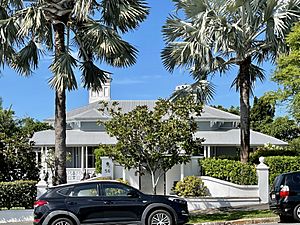Roseville, Teneriffe facts for kids
Quick facts for kids Roseville, Teneriffe |
|
|---|---|

Roseville, 2021
|
|
| Location | 56 Chester Street, Teneriffe, City of Brisbane, Queensland, Australia |
| Design period | 1870s - 1890s (late 19th century) |
| Built | 1886 |
| Official name: Roseville, Uradah | |
| Type | state heritage (built) |
| Designated | 25 June 1993 |
| Reference no. | 600266 |
| Significant period | 1880s (fabric, historical) |
| Significant components | kitchen/kitchen house, residential accommodation - main house |
| Lua error in Module:Location_map at line 420: attempt to index field 'wikibase' (a nil value). | |
Roseville is a historic house located at 56 Chester Street in Teneriffe, a suburb of Brisbane, Queensland, Australia. This beautiful one-story house was built in 1886. It is also sometimes called Uradah. Because of its special history and design, Roseville was added to the Queensland Heritage Register on June 25, 1993. This means it is protected as an important part of Queensland's past.
History of Roseville
This large, one-story house sits on the side of Teneriffe Hill. It was built around 1886 for George Myers. George Myers was a very successful businessman in Brisbane. He owned a popular store on Queen Street that sold china and glassware. He also built a warehouse on Edward Street in 1889, which is now the Metro Arts Theatre.
The land where Roseville stands was once part of a large property owned by James Gibbon. George Myers bought the land in 1885 from an architect named James Cowlishaw. It's possible that Cowlishaw, being an architect, might have even designed the house himself! The house was named Roseville because George Myers created a huge rose garden around it.
In 1887, Cowlishaw sold the property. Then, in 1891, the house was bought by Mrs. Ann Cowell. She decided to rename it Uradah, after a family property she had in Longreach. Over the years, Roseville has had different uses. It was once a hostel run by a group called the Society of the Divine Word. Later, it became a restaurant also called Roseville. In the early 1980s, when it was changed into a restaurant, some parts of the house were updated. This included new decorations inside, new stained glass windows, and fixed-up verandahs. A new two-story building was added at the back for services, and the original kitchen area was made more modern.
What Roseville Looks Like
Roseville is a one-story brick building that has been covered with a smooth finish. It is surrounded by verandahs made of timber and decorative ironwork, which look like lace. The roof is made of corrugated iron. The main part of the roof is shaped like a "U" and has decorative brackets. A curved verandah roof sits below it. Two large, decorated chimneys rise up from the roof. At the back of the house, there was a separate brick service building on a stone base, which has now been connected to the newer parts of the house.
The front of the house, facing the street, looks very balanced. It has two bay windows that stick out, and a main entrance in the middle. The entrance has a decorative wooden archway with columns, and wide stairs made of stone with curved sides.
The verandah has special posts with decorative wooden pieces. The eastern part of the verandah has been enclosed with glass. The edge of the verandah sits on a screen made of bricks with holes, and the house itself rests on a stone base.
Inside, the rooms are arranged along a central hallway. Two of the grandest rooms are located near the front. The entrance part of the hallway has a floor made of small, colorful mosaic tiles. The house also features four marble fireplaces, different ceiling decorations, and fancy wall and ceiling moldings. French doors and large windows open out onto the verandah.
The gardens around Roseville have also been improved. They now include pretty pools, small waterways, flowerbeds, and lots of plants. Even with all the changes over the years, the main part of the house still looks and feels much like it did when it was first built.
Why Roseville is Important
Roseville was added to the Queensland Heritage Register on June 25, 1993, because it meets several important requirements:
- It shows how Queensland's history developed.
Roseville is important because it helps us understand how the Teneriffe area grew and changed over time.
- It shows what a typical house from its time looked like.
Roseville is a great example of what a Brisbane house from the 1880s would have looked like. It shows the main features of homes built during that period.
- It is beautiful and important to the community.
Roseville adds to the special look and feel of Teneriffe Hill. Its beauty is valued by the people who live in the area.
Images for kids


